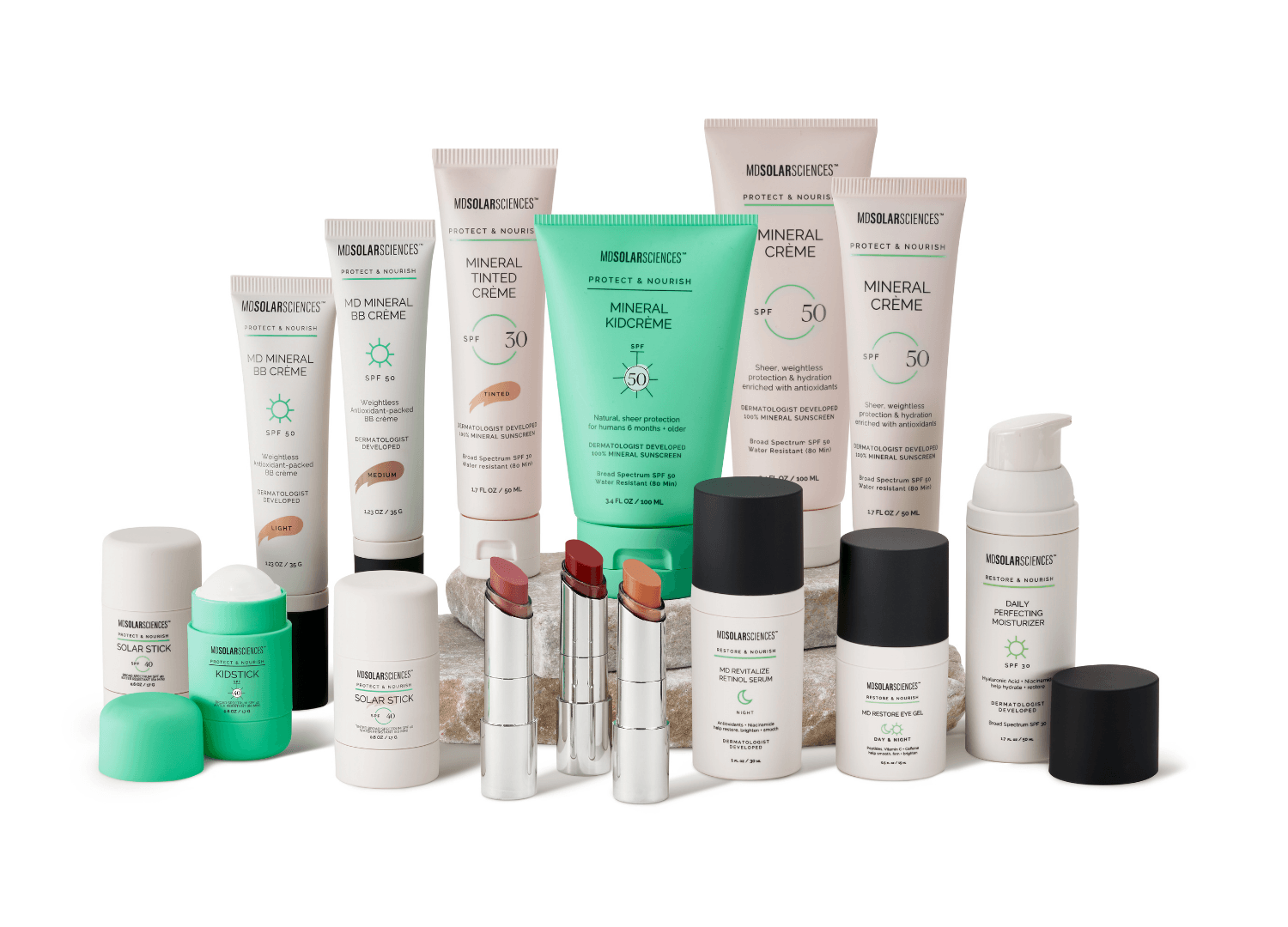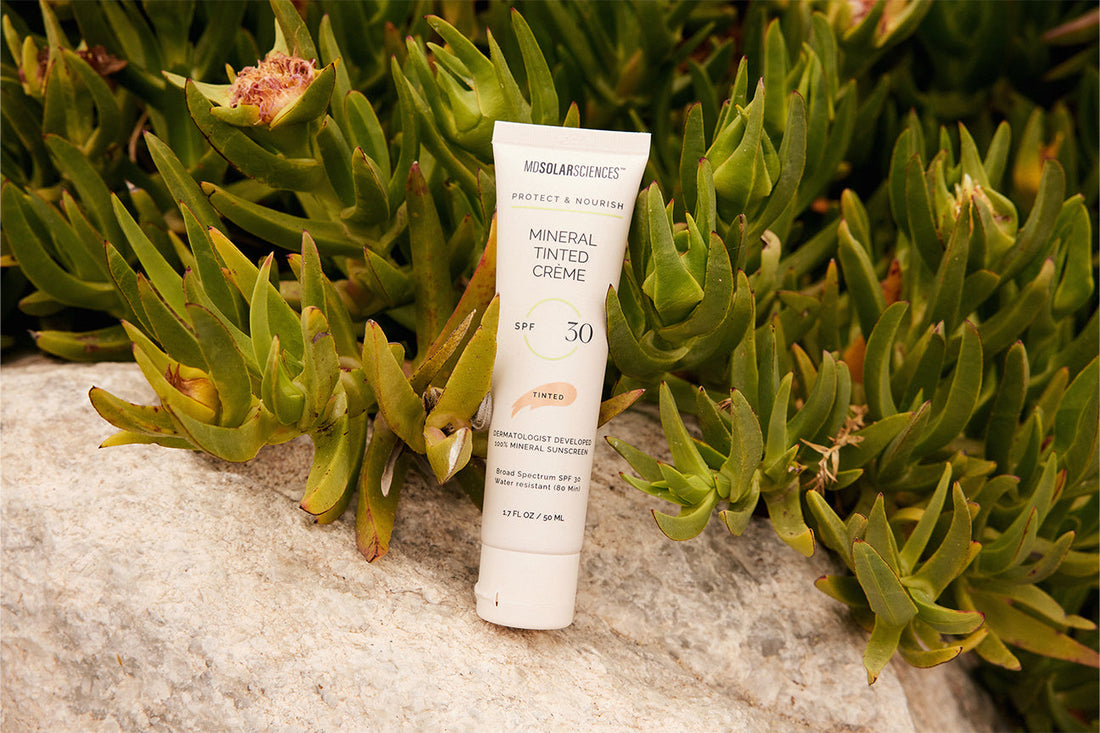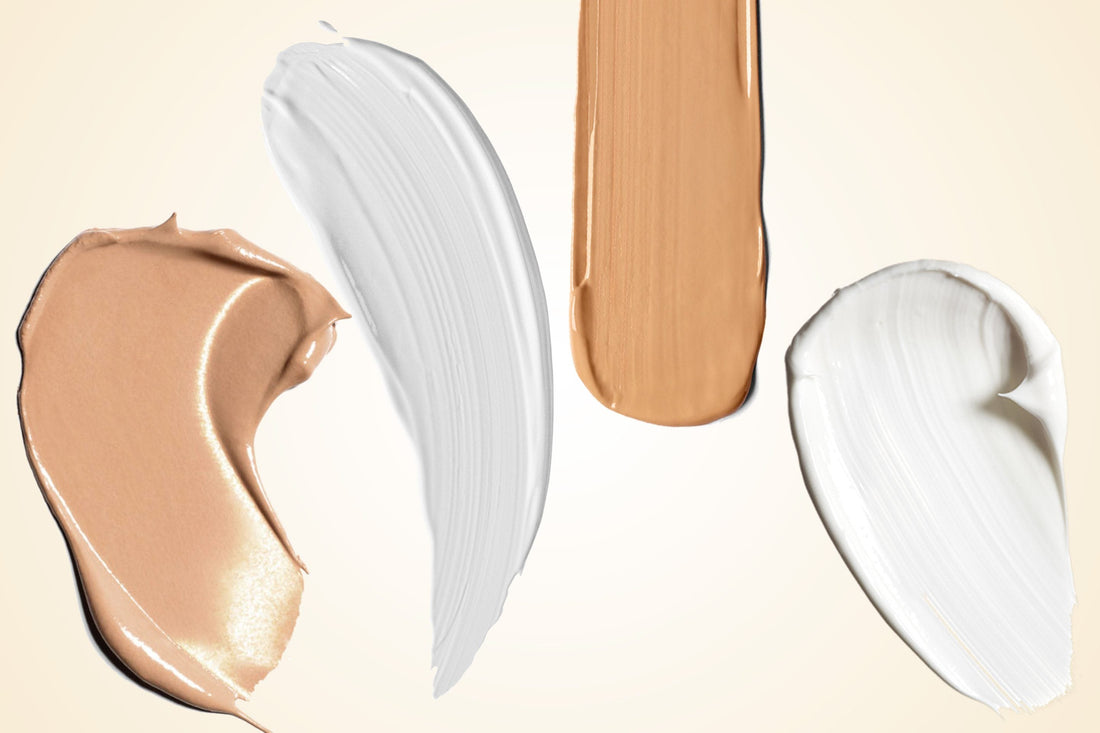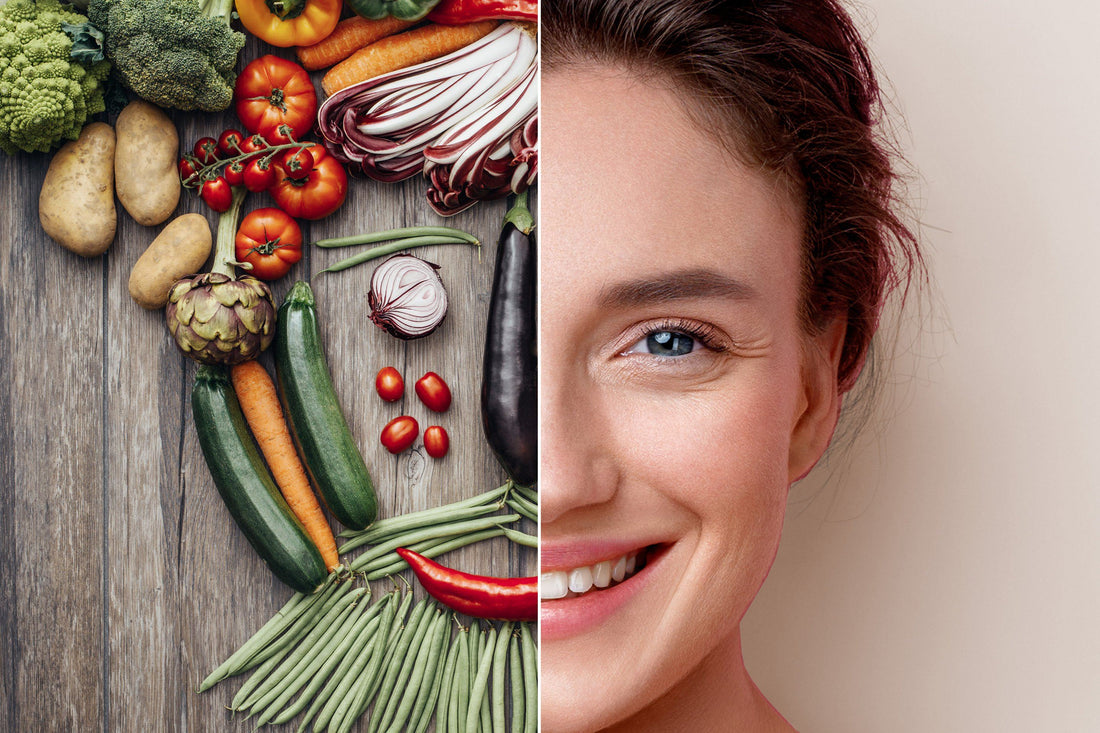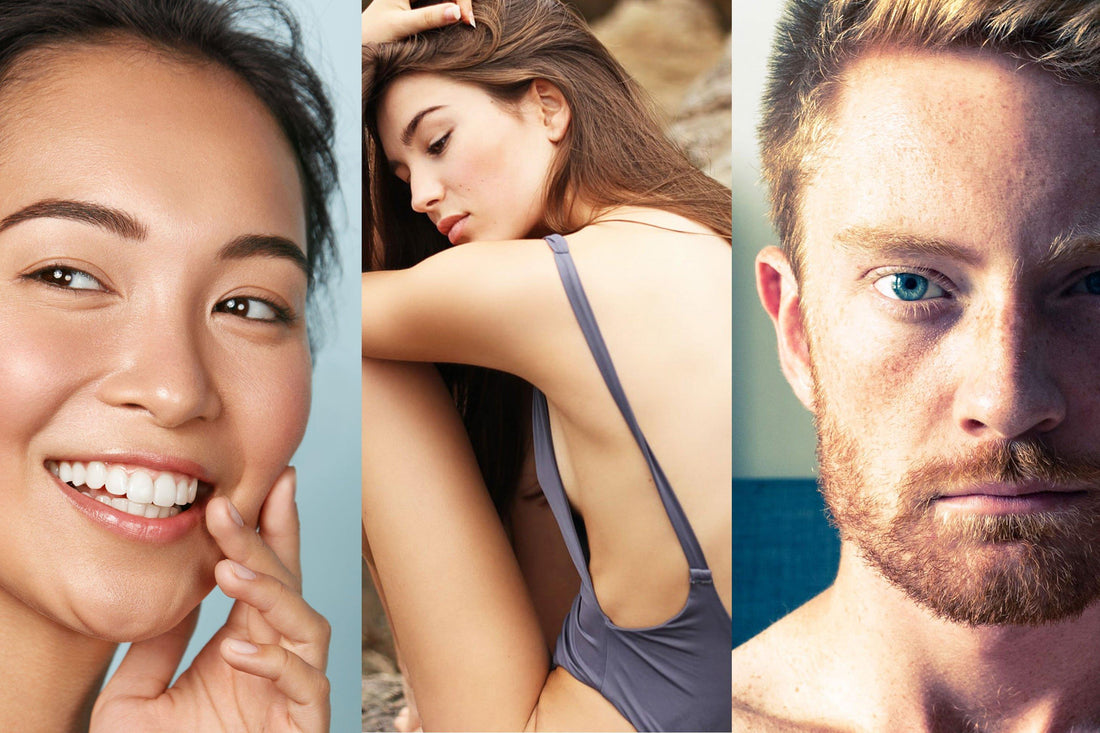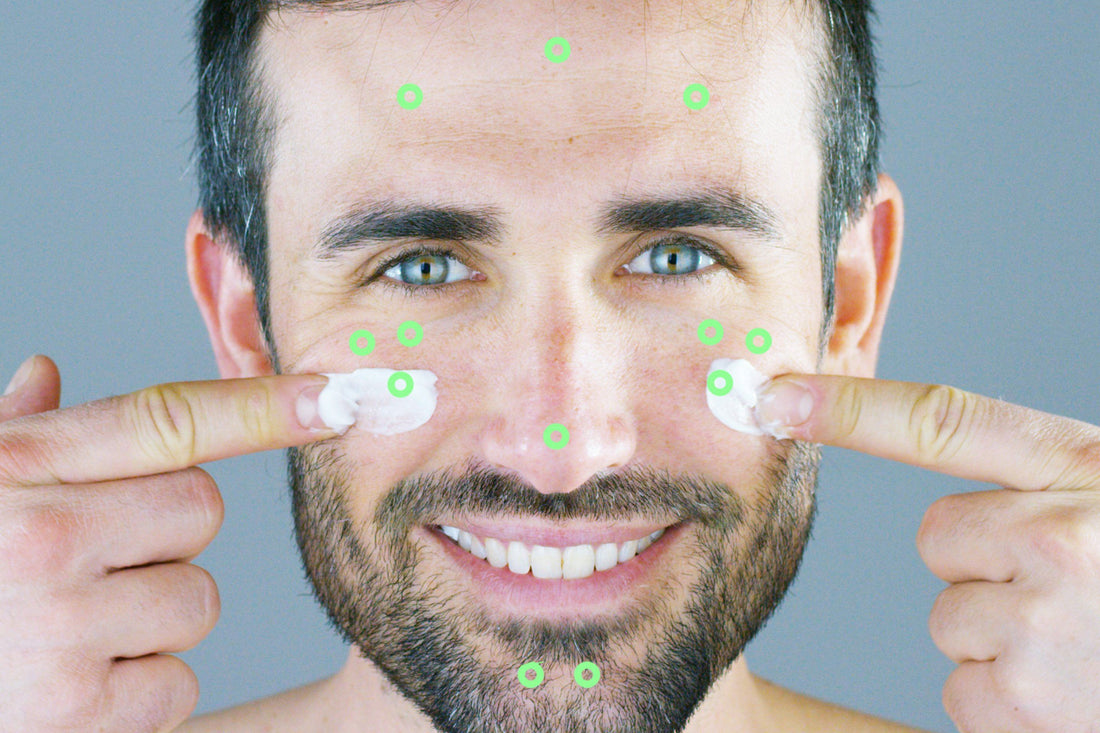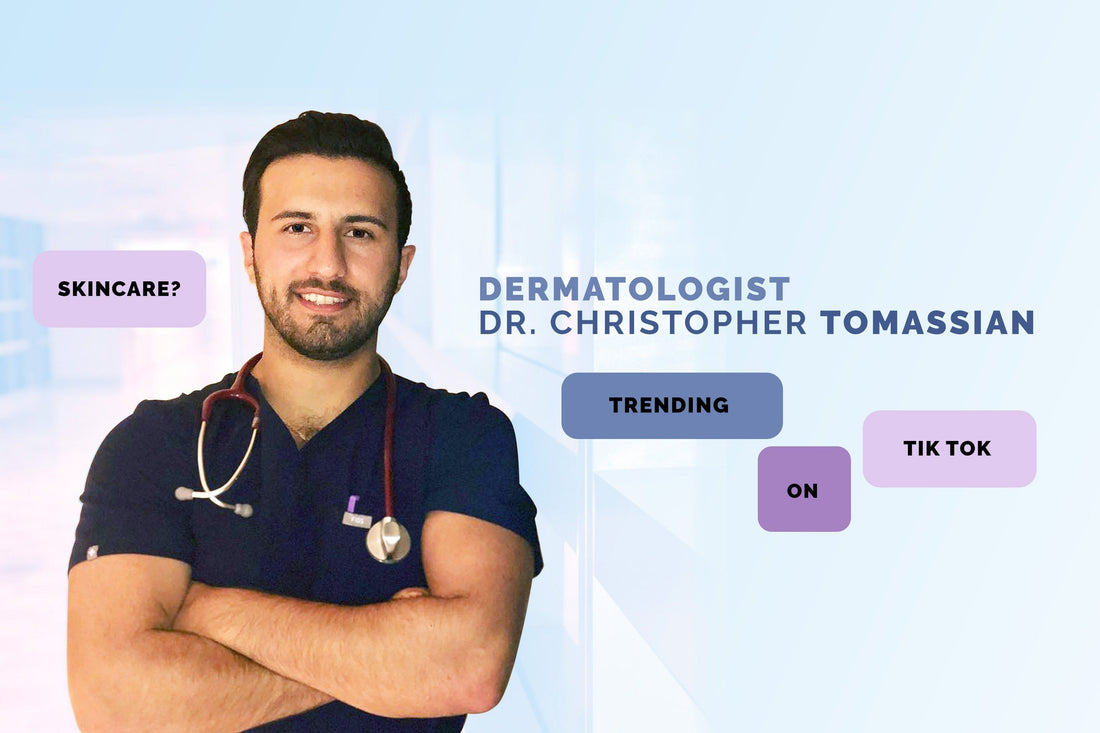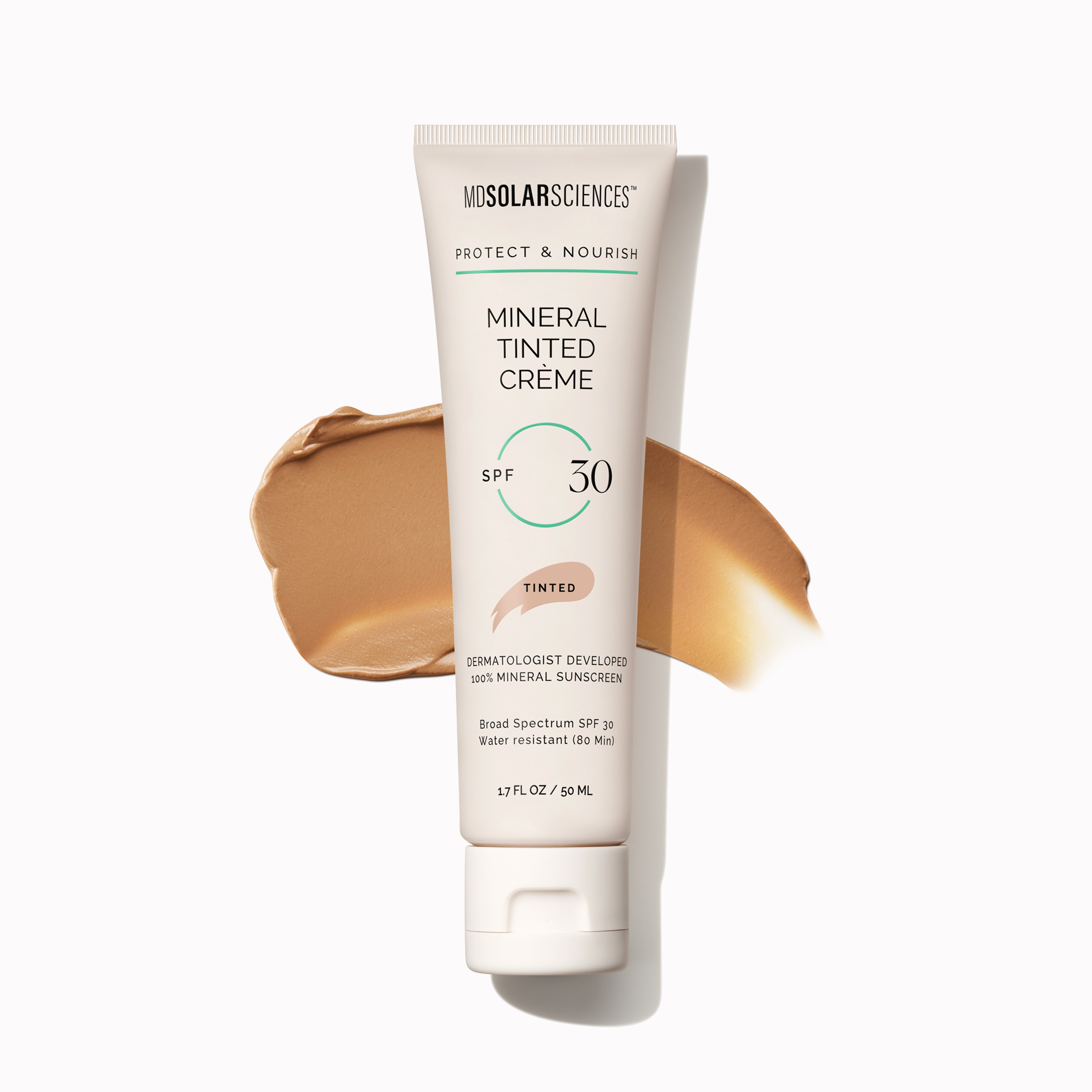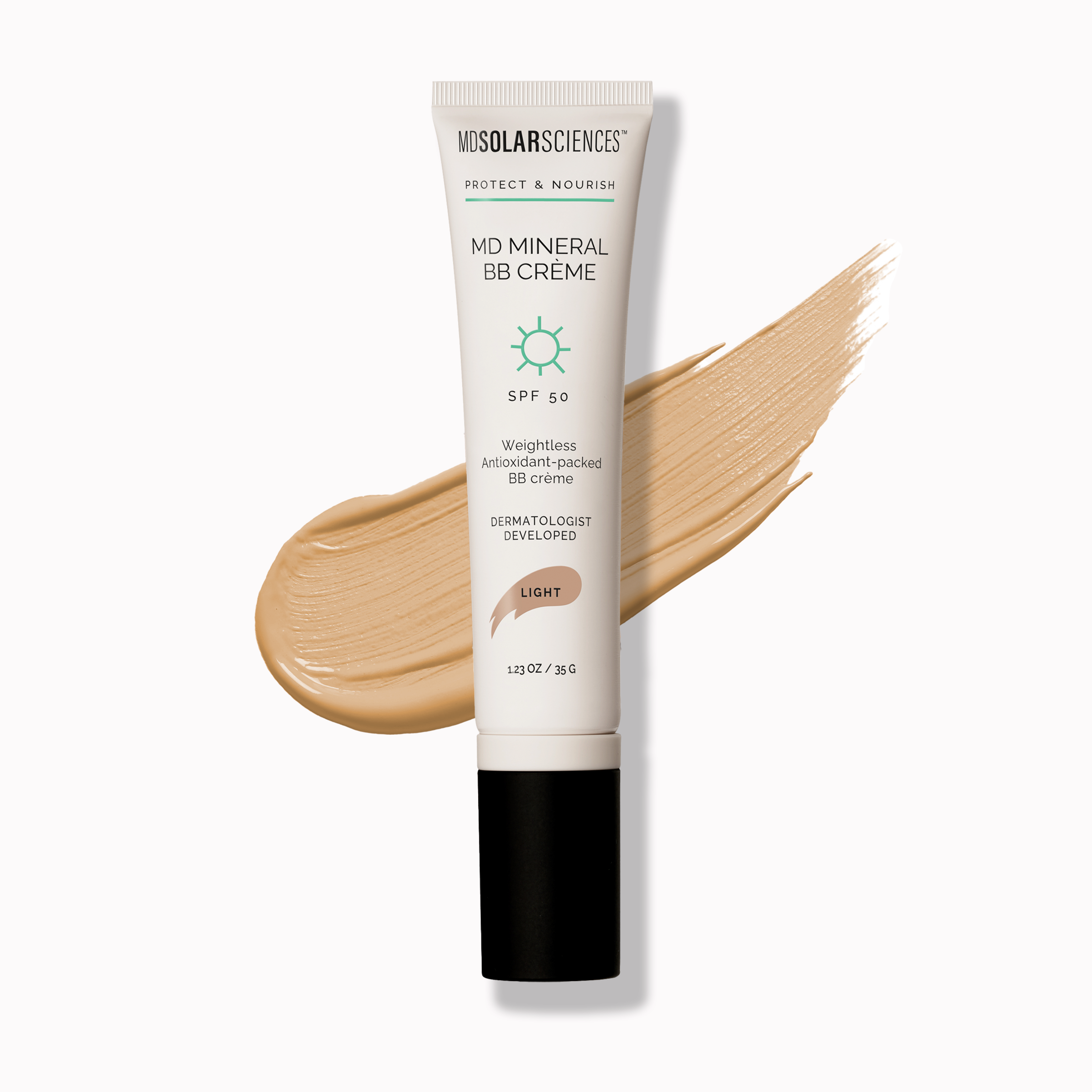Blog: Everything Under the Sun
Respect Your Skin and Our Seas
Educate Yourself and Choose the Best Sunscreens to Protect Your Skin and Our Ecosystems. Warmer weather is finally here! Time for some fun in the sun and beach days galore! While SPF should be part of your daily skincare regimen, we know that most people only pull out the sunscreen in the warmer months. Which means, it’s probably time to refresh your sun care collection (yes, sunscreen does expire, check this blog! ). However, before you do, consider this: Did you know that certain chemicals in sunscreens are toxic to coral reefs and other marine life? It’s estimated that approximately 14,000 tons of sunscreen end up in coral reefs per year causing impactful and irreversible damage. Coral reefs aren’t just home to hundreds of species, they also help reduce climate change by regulating carbon dioxide levels in the ocean, stabilize the ocean floor, filter and clean sea water, plus prevent coastal erosion and storm surge damage. Sunscreen pollution can also impact marine life by decreasing fertility in fish, causing defects in shellfish and impairing growth of green algae. Several states and islands, including Hawaii, Aruba and the U.S. Virgin Islands, prohibit the use and sale of these sunscreens in an effort to protect our oceans and marine life. But the ocean is vast, making up 71% of Earth’s surface, which leaves a lot of the responsibility up to us and you. Choosing the right sunscreen might seem like a simple task, but it isn’t just about protecting your skin – it’s also about protecting our oceans and aquatic life. HOW TO CHOOSE THE BEST ECO-FRIENDLY, REEF-SAFE SUNSCREEN The term “reef-safe” is not a regulated label you can always trust. That’s why it’s important to look out for certain ingredients and attributes to ensure you make an educated SPF choice. Here’s where to start: Always choose oxybenzone-free and octinoxate-free formulas Oxybenzone and octinoxate are two commonly used active ingredients in chemical sunscreens because they’re great at absorbing harmful UV rays to protect your skin. Unfortunately, though, they’re not reef-friendly and are known to cause serious damage to coral reefs, aquatic life and even water quality. You can see the list of Active Ingredients on the back of your SPF carton or tube, in the Drug Facts box. It’s okay if you prefer chemical SPF, just make sure to check the ingredients label and always choose oxybenzone-free and octinoxate-free. While we’re at it, here are other reef-harming ingredients to avoid: PABA, parabens, triclosan, and camphor. Consider 100% mineral SPF An alternative to traditional chemical sunscreens, these formulas can be better for our oceans, and our environment. In order for sunscreen to be considered 100% mineral, it can only contain two active ingredients: zinc oxide and titanium dioxide. Neither of which are linked to coral bleaching. For more information on mineral sunscreens, check out this blog. If you choose mineral SPF, make sure it's a “non-nano” formula Mineral formulas come in two variations: nanoparticles and non-nanoparticles. Nano size particles can be ingested by coral reefs or absorbed by your skin. Non-nano formulas have a greater particle size that cannot be ingested by coral reefs, and stays on top of the skin.. Broad-spectrum protection is a must Make sure your sunscreen provides broad-spectrum protection, which means it protects against both UVA (aging) and UVB (burning) rays. Additionally, never consider anything less than SPF 30 as this is the minimum required to ensure you’re adequately protected. (All of our SPF formulas were developed to provide broad-spectrum protection and come in SPF 30, 40 and 50 options!) Go for water-resistant sunscreen These are formulated to stay on the skin when it gets wet, whether you are swimming or sweating. They typically last up to 80 minutes in the water, which means less of it will wash off in the ocean. Water-resistant sunscreens, like ours, will keep your skin protected longer, yet, as a rule, you should reapply every 2 hours for maximum protection. Look for recyclable SPF packaging As we all know, marine life doesn’t just have a sunscreen pollution problem, it also has a plastic problem. Go the extra step on your SPF hunt by choosing sustainable packaging. Look for anything that’s reusable, biodegradable or fully recyclable. As of 2021, ALL of our packaging is fully recyclable! Wear more UPF clothing A simple way to cut back on sunscreen pollution? Wear less in the ocean! This is not to say that you should go unprotected. Instead, opt for UPF clothing and other sun protective gear (i.e., sunglasses, hats, etc.) that can provide the majority of the protection for your skin. That way there’s less surface area that requires SPF. Check out UVSkinz for some great options. WE MAKE CHOOSING SAFE SUNSCREEN EASY MDSolarSciences™ is committed to offering clean, sustainable chemical and mineral formulas. Ours are made with EcoCert, or organically-certified, Zinc Oxide. We do not use PABA, oxybenzone, parabens or octinoxate. All of our SPF formulas carry the Skin Cancer Foundation seal of approval and these formulas are gentle enough for children 6 months or older, and adults. And, of course, our sun care is reef-safe, cruelty-free and several products in our collection are top EWG-rated by the Environmental Working Group, an organization dedicated to protecting human health and the environment. We are committed to helping preserve our fragile marine ecosystems as well as skin health for you and your loved ones! Check out our reef-friendly SPF here. For more information about our commitment to sustainability, check our Sustainability Report Blog. The best thing you can do for our ecosystem? Be an advocate! Educate yourself, and others, about the importance of using reef-safe sunscreens as part of saving our marine environment. Visit websites like theoceanagency.org, seasave.org or savethereef.org for more information and resources.
Learn moreFall in love with our silky, smooth and lightweight sunscreens!
How likely are you to use a product that may deliver great results, but doesn’t feel good on your skin? Chances are, you would probably avoid wearing it. When skincare and suncare formulas are too thick or even too thin in consistency, they can be unpleasant to wear. What ends up happening? If they are too heavy on the skin or under makeup, your skin will feel uncomfortable, pores may get clogged causing breakouts and, ultimately, causing you to stop using the products that were meant to keep your skin healthy-looking and protected in the first place. Are thicker formulas more effective? Years ago, many products did have a thicker consistency and, yes, the thicker the consistency, the more effective they were thought to be. And who doesn’t remember wearing a coating of white on their skin and nose during the summer? Well, both skincare and sun care formulas have evolved. Companies have partnered with skincare professionals, dermatologists, who know the skin on an intimate level. These professionals help in developing incredibly effective products, using sustainable and efficacious ingredients. These work in tandem to deliver benefits-driven formulas with textures that glide onto skin. Products do not look or feel heavy on the skin anymore. Lightweight sunscreens and soft-to-the-touch formulas are more likely to become part of your daily skincare (or sun care) regimen, keeping skin protected and in peak condition. I don’t like anything that feels heavy on my skin but know I should wear a daily SPF. What should I look for in a product? “One of the top reasons many people don’t wear sunscreen is that they don’t like the way it feels. Most SPF formulas just don’t feel good. They can be goopy, greasy, sticky, leave a white cast or sting eyes” states Renee Plato, CEO of MDSolarSciences™. “Choose natural, lightweight SPF sunscreens that are also reef-safe and cruelty-free” she adds. In addition, look for products that are vegan, gluten, paraben, fragrance and oil free. This will keep skin irritation at bay. Mineral-based formulas are less irritating on the skin and won’t sting eyes, they may be more suitable to people with sensitive skin. Chemical SPF formulas are also very effective. Make sure that the chemical active ingredients are reef safe (no oxybenzone or Octinoxate) and that the formula provides Broad Spectrum protection against both UVA and UVB rays. And, most importantly, know what ingredients are in the products you choose. What makes a product feel good on my skin, while still delivering benefits? When developing a skin or sun care formula, a cocktail of ingredients is crafted with complexes of powerful and protective antioxidants, fruit extracts that can help calm and soothe skin without causing irritation. Green tea, grape or pomegranate extracts are hydrating and nourishing. Vitamins C and E can have a natural brightening and softening effect. When choosing a product, check whether the brand is endorsed by Dermatologists, or third-party organizations like the Environmental Working Group (EWG), the American Skin Cancer Foundation or other. MDSolarSciences™ mineral sunscreen formulas are highly ranked by the Environmental Working Group (EWG). All our SPF formulas carry The Skin Cancer Foundation recommendation seal. Our products are developed and approved by dermatologists with clean, fragrance-free, tear-free formulas that have velvety-soft textures that easily glide onto skin. Sunscreens so lightweight, they have a barely-there touch and feel and can be worn alone or under makeup. Skin will feel breathable and no complaints from adults or kids! Our skincare is formulated for all skin types. Lightweight and fragrance-free, daily wear eye emulsion and restorative SPF moisturizers and beauty balms as well as night serum provide well-aging benefits with silky-smooth textures. Perfect for any daily (and nightly) skincare regimen. MDSolarSciences’ Mineral SPFs are suitable for all skin types including acne, rosacea prone and sensitive skin. They consistently receive high rankings from EWG and their texture is unparalleled. And our Lip Balms combine great sheer tints with broad spectrum sun protection and long-lasting hydration. To learn more about MDSolarSciences and our unique formulas, check out this blog. Make SPF part of your daily regimen, every day and everywhere you go!
Learn moreUnderstanding Skincare Ingredients...Harnessing Their Natural Power.
Skincare products come with a long list of ingredients that sound more like a recipe than a listing. Technically, that is exactly what they are. Each is chosen based on their efficacy in delivering product benefits and how well they work with other ingredients to give your skin what it wants and needs. MDSolarSciences™ daily sunscreen products for face and body, were developed with this in mind, making sure each formula is as efficacious as possible. WHAT IS IN MY SKINCARE AND WHAT ARE THEIR BENEFITS? ANTIOXIDANTSKey in superior skin and sun care, antioxidants can be found in other ingredients in formulas, protecting the skin from environmental damage and signs of aging in the skin. As part of a daily skincare routine, they can diminish the appearance of sun spots, help combat visible signs of aging and calm skin irritation. A more even tone, without redness or irritation promotes younger, healthier-looking skin. There are so many different antioxidants, some more potent than others. EXTRACTSGreen Tea, Pomegranate and Grape are just some extracts found in skincare and sun care products. Rich in antioxidants, they hydrate while helping protect skin against environmental aggressors and future damage which lead to signs of aging. Found in sunscreens, these extracts enhance the effectiveness of sunscreens. Water-based extracts, like Seaweed, help reduce signs of dehydration. This particular extract can help boost levels of hyaluronic acid, found naturally in the skin. Acting in tandem, they help improve elasticity in skin as well as maintain a healthy moisture balance. VITAMINSVitamin C is one of the most powerful antioxidants, followed by protective Vitamin A and nourishing Vitamin E, are found in better skincare products. Vitamin A, a natural anti-inflammatory, reduces skin sensitivity, shielding against redness and pigmentation, while Vitamin E softens and comforts skin. These key antioxidants address current damage by increasing cell turnover, naturally sloughing off dry or dead cells. As part of a skincare regimen, products with these vitamins will brighten, improve tone and maintain healthier-looking skin, giving you a more luminous look. CHAMOMILENaturally soothing and calming, the antioxidants contained in Chamomile help protect against sun damage. This ingredient is hypoallergenic and can reduce redness, neutralize skin irritants and help relieve irritation while promoting smooth, healthy-looking skin. BRIGHTENERSNiacinamide helps increase cell turnover by naturally removing dead skin cells. This helps even tone and diminish the appearance of dark spots, thus brightening your overall complexion. Rose Hips contain high levels of Vitamins A and C to provide a powerful antioxidant boost, protecting skin from UV damage. This ingredient also delivers brightening benefits along with fatty acids that promotes a healthy skin barrier. CAFFEINEFound in many pro-aging products, caffeine naturally decreases puffiness by drawing excess fluids out of cells. This helps tightens and tones skin, creating a more youthful appearance. Its natural soothing properties help to reduce swelling and redness, leaving a brighter, more even tone. It can also diminish the appearance of fine wrinkles and darkness under the eyes. ZINC OXIDE AND TITANIUM DIOXIDEThese organic minerals, also referred to as “actives”, provide a protective barrier between you and the sun, keeping redness to a minimum. Both are non-comedogenic; they won't clog pores. They provide broad spectrum sun protection against UVA and UVB rays. BROAD SPECTRUM SPFThis form of SPF goes through rigorous testing requirements to provide high level protection against both UVA and UVB rays. The higher the SPF, the higher the protection against the damaging effects of these rays. MDSolarSciences™ products are uniquely formulated with intelligent ingredients that work together to deliver powerful antioxidant combinations and benefits-driven results to keep your skin protected while maintaining a younger and healthier-looking complexion. For more detailed information on our clean beauty, cruelty-free products and ingredients, please click here. Below is a list of these ingredients by product: Mineral Moisture Defense SPF 50Antioxidants Vitamin C, Green Tea, Cranberry Fruit and Pomegranate ExtractsActives: Titanium Dioxide and Zinc Oxide Daily Perfecting Moisturizer SPF 50Contains Chamomile, Seaweed Extract, Niacinamide and Caffeine.Antioxidants Vitamin C, Rose Hips, Grape, Rosemary & Green Tea Extracts Mineral Crème SPF 30, Mineral Tinted Crème SPF 30, Mineral Crème SPF 50Antioxidants Vitamins C and E, Green Tea, Cranberry Fruit, Pomegranate Extracts Actives: Titanium Dioxide and Zinc Oxide MD Mineral BB Créme SPF 50Caffeine, Niacinamide and antioxidants Vitamins C and E, Green Tea, Cranberry Fruit & Pomegranate ExtractsActives: Titanium Dioxide and Zinc Oxide Everyday Nourishing Lotion SPF 50Antioxidants Vitamin C, Rosemary, Seaweed and Green Tea Extracts MD Restore Eye GelCaffeine, Niacinamide and antioxidants Vitamin C, Rose Hips, Grape, Rosemary & Green Tea Extracts MD Revitalize Retinol SerumCaffeine, Niacinamide, Chamomile, seaweed extract, as well as antioxidants Vitamin C, Rose Hips, Grape, Rosemary & Green Tea Extracts. Also contains encapsulated and stabilized retinol. Hydrating Sheer Lip Balm SPF 30 (3 shades)Tinted lip balms with SPF containing hydrating shea, avocado and olive butters. KidCréme SPF 50, KidStick SPF 40Sunscreen for babies and kids (6 months and up).Contains Antioxidant Vitamin E.Actives: Titanium Dioxide and Zinc Oxide
Learn moreFace, Body and Lip Sunscreen… What’s the Difference?
Can I use the same SPF on face, body and lips? All dermatologists recommend wearing sunscreen and reapplying it within a few hours to keep your skin protected from harmful sun rays. Beyond reapplication, it’s also important to think about the areas that often get forgotten… and which ones are the most important. Our faces are definitely the most exposed parts of our bodies. They are at a higher risk of absorbing UV rays. If you haven’t checked out our other blog, ‘Different types of UV rays’, the rays that mostly contribute to the damage dealt to your skin are UVA and UVB rays. These rays contribute to the UV radiation being absorbed on your skin due to their penetration capabilities and may cause short-term and long-term damage to your skin ranging from sunburns to more serious consequences. Too much exposure to these UV rays causes premature aging such as dryer skin, fine lines, wrinkles, and impaired pigmentation. With that in mind, the skin on our lips is also very sensitive, more sensitive than you might think, making it prone to damage from sun exposure. That damage can gradually break down collagen and result in thinning, drying, and cracked lips. So what can you do? First of all, make sure you have your sunscreen handy. It's ok and safe to use 'Face' sunscreen on your body and vice versa. A Body lotion with SPF will most likely include a hydrating component like Ceramides. Our Mineral Moisture Defense is formulated that way and will give you the extra hydration you might need on your body. It locks in moisture by helping the skin’s natural lipid barrier with a unique blend of Ceramides and humectants. You can also use it on your face, just keep in mind that it has that extra hydration component, which may be good if your skin is on the dryer side. What about lips? Your lips need more physical protection from the sun and the wind than the rest of the face. They also get wet throughout the day, and may be exposed to irritants. Our lip balm contains oil and waxes to ensure that the sun protection element stays on top of the lips to create a barrier against all those environmental stressors. The idea is to create a nourishing cushion that stays on top of the lips to prevent water loss (transepidermal water loss). Some of the oils and humectants get absorbed in the lips and help to keep them soft and supple, while the SPF stays on the surface and protects them from the sun, potential water loss and other environmental stressors. Last but not least, as Dr Britt Craiglow pointed out in our 'Sunscreen for Kids' blog, make sure every area of exposed skin is covered with SPF. Think of the unusual areas like behind the ears, the neck, hands and feet of course. For those areas, our regular or tinted stick are great options for last minute or ‘on the go’ application/reapplication. USING YOUR FSA/HSA DOLLARS TO BUY SPF: Using sunscreen regularly may prevent skin cancer and decrease the effects of aging. Dermatologists generally recommend using a broad-spectrum sunscreen, meaning it covers both UVA and UVB rays. This is why Sunscreens that are SPF 15 and above and provide broad spectrum protection are covered under FSA/HSA dollars. We recommend using a sunscreen with an SPF 30 or higher, and to wear it any time you're going outside, even during the winter or on a cloudy day! Head over to FSAstore.com now before the December deadline to use your FSA/HSA dollars.
Learn more7 steps to perfect SPF application
Even in our Covid world, life can be a fast-paced rat race of whirlwind coffee runs, online school or school drop offs, and zoom meetings – seemingly leaving no room for skincare. And besides, sunscreen is just for summer, right? Not quite… SPF is the first, most important step in anti-aging, and it’s necessary every day – even inside (wrinkle-creating UVA rays shine right through windows) and even in the winter (UVA remains strong all year long). But don’t worry – gone are the days of sticky, goopy sunscreen. Our SPF products fit right into your routine and lifestyles, with luxurious textures you’ll actually want to wear. There’s no reason to drop everything and reinvent the wheel to introduce sun protection into your day, but it’s certainly important to make sure it’s in your routine. Your skin will love you for it, we know it. If you’re already using sunscreen every day in a BB crème, foundation or moisturizer, you’ve taken the first step to keeping your skin safe and beautiful! However, you may not be applying it close enough to your hairline, or on your neck, ears or chest, and it may only have SPF 15 protection. “The absolute minimum SPF you need to wear on your face every day—even if you’re just sitting in an office or a classroom until dusk—is SPF 30,” says Dr. Mona Gohara (Allure). Beyond that, make sure that your product is broad spectrum – meaning that it will protect you from both the burning UVB rays and aging UVA rays. If it doesn’t say “broad spectrum” – your sunscreen is only doing half the work. Sure, saving ourselves from sunburn is important, but the ‘Future You’ will be oh-so pleased that you’ve been preventing wrinkles and age spots all along. Mapping out your face (or other desired areas) to ensure that you cover fully with sunscreen is important, and we’ve developed a 7 steps checklist to help you get the most of your sunscreen! 1. Be Generous According to The American Academy of Dermatology, most people only apply 25-50% of the recommended amount. “A dab’ll do ya” doesn’t work so well when it comes to sunscreen. It’s important to make sure that you’re covering every area – we’ve all fallen victim to splotchy sunburn. Everyone is different, but NYU School of Medicine dermatology professor and NYC dermatologist Dr. Elizabeth Hale suggests you apply at least “a nickel-sized dollop to the face alone” and approximate a shot-glass full for exposed areas of the body (the equivalent of 2 tablespoons). 2. Check yourself in a mirror Watch yourself in the mirror during application, taking care to apply evenly and hit easy-to-miss spots like ears, your hairline, or neck. If the sun sees it, it’s susceptible to sun damage. We can try and feel our way through sunscreen application, but seeing is believing. Apply in small areas and only move onto the next body part once you are sure that you’ve applied enough that the area you’re focusing on is completely covered. 3. Apply before you leave the house Sunscreen should be applied at least 15 minutes before sun exposure. Chemical formulations take this amount of time to reach their full protection potential. While mineral sunscreens begin working immediately, to create good habits we always suggest applying before heading outdoors. Plan ahead! Chances are you won’t find a mirror outdoors, so be sure to apply consciously and carefully. If you wait until you’re outside to start spraying on your sunscreen, you’ve actually exposed your skin to the sun’s harmful rays for at least 15 minutes, which for some, is enough time to get badly sunburned, and upping your chances for melanoma or skin cancer later on. 4. Massage it in Gently massage the product onto skin to ensure proper blending. When applied in the mapped sections of the face, the product does blend more evenly, without leaving behind any white cast. Blending the map points together lightly is all it’ll take for the crème to cover skin evenly; if you feel you need more product, map and blend again! Mineral formulations sit on top of the skin’s surface, so they’re historically known to be a bit tougher to blend in. If you try and rub a large amount of mineral sunscreen onto a small area, it’s much more difficult for the product to blend. 5. SPF over makeup works Apply over makeup as a mattifying finishing touch or to make reapplication easy during the day. If you apply sunscreen in the morning, that’s a great first step to healthier skin; but even the most powerful sunscreen won’t last all day. You can reapply directly over foundation, bronzer, and blush – blend gently, and your makeup should stay in place. 6. Under makeup works too! Worn alone or underneath foundation, the matte finish of our mineral formulations makes them great primers, like the Mineral Crème SPF 50. The texture smooths over skin providing a blurring, “Instagram filter” effect to the skin, and with a matte finish – your foundation will set beautifully on top. If mineral formulas aren’t your favorite, our Daily Perfecting Moisturizer SPF 30 keeps skin looking dewy and refreshed, while keeping makeup in place. 7. Reapply Try to reapply at least every 2 hours and immediately after swimming, sweating or towel drying. Although most of our formulas are water resistant for 80 minutes –reapply after you’ve dried off to ensure that you’re getting the full protection promised by the sunscreen. Shop our full collection of skincare and sunscreen products here.
Learn moreAn Interview with Dr. Friedman
In today’s blog, we revisit an interview with Dr Friedman. He had an incredible professional career in New York City. We know him as our founder, a truly respected dermatologist who had a significant impact on skin cancer prevention, treatment and education. He was also one of the brilliant minds at NYU Langone Medical Center who developed the ABCDEs of Melanoma, a skin cancer detection technique. Read on to learn his motivation behind starting the company. SO, DR. FRIEDMAN, WHY DID YOU WANT TO START MDSOLARSCIENCES™? The short answer is that I wanted to help people. I’m a dermatologic oncologist by profession, so I see more than my fair share of skin cancer. I’ve seen what it can do to someone’s life. I’ve seen the pain, the fear, the loss of confidence, even the loss of life that can follow a diagnosis. Many of my days have been spent helping people who already have skin cancer, but I wanted to do my part in decreasing the likelihood of the disease. I love telling people that they are cancer-free, so it seemed like the next logical step to fight skin cancer at its source. If I can put myself out of a job, I’ll be happy. WOULD IT BE FAIR TO SAY THAT YOUR PATIENTS INSPIRED THE CREATION OF THE BRAND? Absolutely! I made a deal with my patients: I’ll treat you, but you have to wear sunscreen every single day. I thought it would be an easy deal to make, but it was such a real struggle to get people to comply. I would constantly hear that sunscreen was too sticky, greasy or whitening. Eventually, I realized that they were right. I knew I could create a line of products with luxurious, high-end aesthetics that fit seamlessly into your everyday routine; all while providing safe, effective coverage. So that’s what I set out to do. DO YOU THINK THERE IS A CERTAIN STIGMA ASSOCIATED WITH SUN PROTECTION? There are certainly a lot of preconceptions about sunscreen. Too many people view it as a chore to be done only when going to the beach, or playing tennis. They expect it to be greasy and heavy and gross. They think that a sunburn is the only price they will pay for overexposure, or that all sun protection products are interchangeable. That’s just not the case. WHAT IS THE ONE THING YOU WANT THE WORLD TO KNOW ABOUT SUN PROTECTION? I want everyone to understand that sun protection is an important part of living a healthy lifestyle, and that it can be easily integrated into a daily routine. The sun is there every day… you should protect yourself every day. The team at MDSolarSciences, led by CEO Renee Plato, carries on the vision of Dr Friedman. Visit our sunscreen page to learn more about our incredible formulas and texture, it is truly SPF you will want to wear every day and everywhere! For Daily protection and hydration, as a base before make up or on its own, check out Daily Perfecting Moisturizer SPF 30. For a tinted SPF, check out our Mineral BB Créme SPF 50 or Mineral Tinted Crème SPF 30.
Learn moreChemical VS. Mineral Sunscreens
Sunscreen is sunscreen, right? Well… not really. There are two distinct forms of sunscreen that protect you in two different ways. Understanding the dangers of the sun’s radiation is important because it allows you to take the proper steps towards complete protection, but understanding how you are protected can be just as important. Finding “Broad Spectrum” on the front of your sunscreen is a must, but what should you look for on the back? What is the difference between chemical and mineral sunscreens? What do sunscreens and cough syrups have in common? No, it’s not the fact that drinking an entire bottle is a bad idea. Actually, drinking any amount of sunscreen is a bad idea. Just to be clear: do not drink sunscreen. So what is the similarity here? Both products are considered over-the-counter drugs. This means that there is a very important section on the back of your sunscreen labeled “Active Ingredients”. The active ingredients are what make a formula a sunscreen. They are the shield that guards you from the sun’s harmful rays. The active ingredients allow you to take that run or that swim without worrying about sun damage. So now that we’ve established what they do, let’s talk a little bit about how they do it. Mineral There are only two active ingredients that fall under the category of mineral sunscreens: Zinc Oxide and Titanium Dioxide. When most people think of the earliest sunscreens, the image of a lifeguard with a white paste on his or her nose comes to mind. That white paste was a mineral sunscreen made of crushed Zinc Oxide. This early remedy was unattractive, but surprisingly effective. Mineral sunscreens do not penetrate the skin. Instead, the active ingredients sit on the top layer of skin and deflect the sun’s rays. This is why that lifeguard never could get that paste to rub in. Zinc is a fantastic sunscreen. It is naturally broad spectrum, meaning it protects against UVA and UVB rays. So why didn’t sunscreens always use mineral actives? It all comes back to that lifeguard’s nose. Nobody knew how to make a mineral product that wouldn’t make you look like a ghost (not the best beach look). The unattractive whitening effect caused people to search out a new method of sun protection, leading to the rise of chemical sunscreens. Today’s mineral active ingredients can be micronized, which is a fancy way of saying we figured out how to crush things even smaller. This allows the most recent products to reduce and eliminate that unappealing whitening effect. Chemical Chemical sunscreens are by far the most prevalent products out there. They protect you from the sun by penetrating the skin and absorbing UV light, kind of like a sponge. Chemical sunscreens solved the whitening problem that plagued early mineral sunscreens, and immediately became the norm. Because chemicals do not sit on top of the skin like minerals, they can be paired with moisturizers that need to penetrate skin to be effective. Despite these advantages, chemical sunscreens do have some limitations. There are no chemicals that can cover the full spectrum (UVA + UVB) by themselves. Each one specializes in a specific segment of the spectrum, which means that they need to be combined with other chemicals to achieve broad spectrum protection. While this is not necessarily a bad thing, the need for more ingredients has led to the use of chemicals that some consider controversial. Oxybenzone, PABA and octinoxate, for example, are common skin irritants. These chemicals can cause sensitivity in at least 10% of the population, but are still among the most commonly used ingredients. Not all chemical sunscreens, however, are considered controversial. Avobenzone is effective at covering the entire UVA spectrum, but needs to be combined with other chemical ingredients to provide broad spectrum protection. The good news is that Avobenzone can be stabilized so that it does not break down in the sun. Brands sometimes prefer stabilized chemicals when they are trying to achieve a certain feel in a formula. Which One is Best? Unfortunately, it’s not that simple. Some mineral and chemical actives can be used together in sunscreens. While these can be effective, they are often misleading. Lots of products have “Mineral” in their title, but are actually hybrids. Take a look at the back of your sunscreen package. In order for something to be fully mineral, the only two active ingredients allowed are zinc oxide and titanium dioxide. While minerals are generally considered safer and more effective, you don’t have to get scared off by chemical sunscreens. Be a discerning consumer. Safer sun protection is easy when you know what to look for. Check out the chart below and visit our sunscreen page for more information on our Mineral/Physical and Chemical sunscreens. Now that you're an expert on physical and chemical sunscreens, head over to our 'UV rays' blog to learn about UVA, UVB and UVC rays.
Learn moreFive Questions with Dr Dray
Dr Dray is a Board Certified Dermatologist and skincare enthusiast based in Houston, TX. She has built a strong presence on Youtube and other social media platforms where she answers her followers' most pressing skincare questions. 1. What is your favorite thing about your job?I like helping patients understand their skin conditions so that they can better manage triggers and modify their skin care routines accordingly. When it comes to chronic diseases, knowledge is power and patients like being able to take control of their skin issues beyond their medications. 2. If you could make all your patients pick up one skincare habit, what would it be? Sunscreen! It makes the biggest difference long term. 3. And if you could make them drop one bad skincare habit, what would it be? Tanning. Nothing destroys the skin faster than a sun tan or a trip to the tanning bed. What are the best skincare routines for the 3 main life stages: 20s, 30s-40s, 50+? Sunscreen, moisturizer, cleanser. Keeping things simple is the best thing for skin across all age groups and is the most sustainable. What is your goal on Tik Tok next year 😊? Or what do you most enjoy about Tik Tok? The TikTok audience is a younger demographic compared to those who follow me on Instagram and Youtube. I hope to tap into this group to influence them to protect their skin from the sun. The younger these habits start, the greater the long term benefits. Dr Dray sums it up best in her bio, "don't forget to sunscreen and subscribe for more!": https://www.youtube.com/c/DrDrayzday/featured https://www.instagram.com/drdrayzday/ https://www.facebook.com/DrDrayzDay/ Check out our other 5 Questions with a Dermatologist blog featuring Dr. Tomassian.
Learn moreQ&A with Dr. Tomassian
Q: What is your favorite thing about your job?A: One thing I truly love about my job is that I can help make changes to someone's skin, skincare routine, or skin disease that helps heal them physically, emotionally, and mentally. It is important for me to help my patients feel their most confident in their own skin. Each patient is so unique and I try my best to help them all individually. Q: If you could make all your patients pick up one skincare habit, what would it be?A: If there is one thing I can ask all my patients to do in regards to their skincare routine it would be applying quality sunscreen (at least SPF 30) every single day. Wearing sunscreen every day not only helps prevent skin cancer but also helps prevent and reduce the appearance of dark spots and wrinkles. Q: And if you could make them drop one bad skincare habit, what would it be?A: Unfortunately, there is a long list of bad skincare habits I wish I could enforce. However, if I had to pick the worst it would be applying products that you don't understand and don't need for your skin. So many people are buying skincare products just because they "look good", send trendy, or have seen someone else use them. Many times adding more than one product into your skin care routine can actually irritate your skin or make your skin worse. Understanding what your skin needs is the first and most important step for a successful skincare routine. Be cautious and careful with what products you start incorporating into your skincare routine. Sometimes, less is more. Q: What are the best skincare routines for the 3 main life stages: 20s, 30s-40s, 50+A: 20s: Cleanser, basic moisturizer, Sunscreen 30s: Cleanser, Vitamin C, Moisturizer, Sunscreen, Retinoid 50 +: Cleanser, Vitamin C, Sunscreen, Retinoid and incorporating a moisturizer with Alpha Hydroxy acids such as lactic acid to help thicken thin skin. Q: What is your goal on Tik Tok next year 😊? Or what do you most enjoy about Tik Tok?A: My goal with my TikTok platform for 2021 is the same as when I started TikTok in April 2020. I want to create valuable, science-based skincare videos that are accessible for everyone. My intention from day one is to make relatable, digestible, and science-based content. It's also very fun for me! I enjoy interacting with users as well as fellow dermatologists. It is so motivating for me to see the results of my content come to fruition. If you have purchased any products you love, changed anything in your skincare routine or have learned anything new about skincare because of my content, please tag me in a post or DM me at @dr.tomassian!
Learn more

